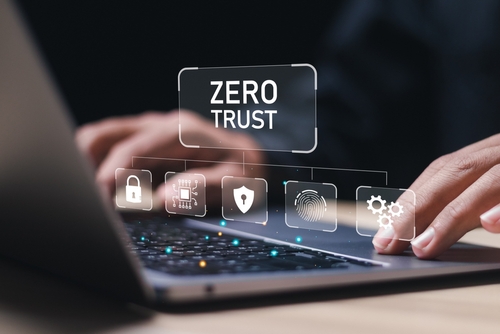ICFiles
SOC 2

Secure File Transfer Soc 2 starts at $1 per month
Zero Trust Security Models: The New Standard Against Data Breaches?
What's New in Technology
October, 2024
Zero Trust Security Models: The New Standard Against Data Breaches?
 As technology evolves, so have data breaches, which have become a significant threat to businesses of all sizes. We frequently hear reports of high-profile attacks on major organizations, global corporations, and even government agencies. Emerging technologies such as generative artificial intelligence and machine learning make cybersecurity more challenging. They enable cybercriminals to automate attacks, create sophisticated phishing schemes, and develop advanced malware to evade traditional security measures. Hence, companies have no choice but to change how they approach cybersecurity.
As technology evolves, so have data breaches, which have become a significant threat to businesses of all sizes. We frequently hear reports of high-profile attacks on major organizations, global corporations, and even government agencies. Emerging technologies such as generative artificial intelligence and machine learning make cybersecurity more challenging. They enable cybercriminals to automate attacks, create sophisticated phishing schemes, and develop advanced malware to evade traditional security measures. Hence, companies have no choice but to change how they approach cybersecurity.
To deal with these modern threats, Zero Trust security models are gaining widespread adoption as the preferred standard for effectively protecting against data breaches.
What is Zero Trust?
Zero Trust is a cybersecurity framework based on the "never trust, always verify" principle. Unlike traditional models that grant access based on network location, Zero Trust requires continuous verification of each user, device, and application attempting to access resources.
Instead of assuming that someone within the network can be trusted, Zero Trust demands constant authentication and least-privilege access. This means users are granted access to only the data and resources they need to perform their tasks. Basically, every interaction is assumed to be a breach.
How Zero Trust Differs from Traditional Security Models
Historically, businesses operated on a "perimeter-based" approach – trusting everything inside their network and guarding against threats from the outside. However, the once-clear network boundary has become unclear with the rise in remote work, cloud computing, and mobile devices. Breaches today can occur internally, often by compromised accounts, rogue insiders, or lateral movement of malware.
Cyberthreats have become such a huge problem that the U.S. government issued an executive order to help improve the nation's cyber security by mandating that federal agencies adopt the Zero Trust architecture. This further pushes businesses to rethink their cybersecurity strategies.
Key Components of a Zero Trust Model
Zero Trust models are built on several core principles:
- Continuous verification - Authentication is ongoing, requiring verification for every request made by a user or device.
- Least-privilege access - Users receive only the minimum level of access needed to perform their jobs.
- Micro-segmentation - Networks are divided into smaller zones, limiting the lateral movement of potential threats.
- Contextual monitoring - Continuous monitoring of users and devices based on context – such as location, device health, and behavior – to identify abnormal activities.
- Multi-factor authentication (MFA) - MFA requires users to provide two or more forms of authentication, such as a password combined with a biometric factor or a security token.
- Encryption - All data must be encrypted to protect it from unauthorized access or interception. Encryption ensures that even if attackers manage to capture data, they cannot read or exploit it without the appropriate decryption keys.
- Access Controls - Applying strict policies to determine who can access specific data and systems based on their role and identity.
Benefits of Zero Trust
- Stronger protection against data breaches - Zero Trust models significantly reduce the risk of data breaches by enforcing strict identity verification and limiting access to only necessary resources. Even if an attacker gains entry, micro-segmentation ensures limited movement, containing threats, and minimizing damage.
- Enhanced regulatory compliance - Zero Trust helps businesses meet regulatory requirements like GDPR and HIPAA by enforcing strict access controls and continuous monitoring. This approach simplifies compliance and ensures that only authorized users can access sensitive data, reducing the risk of fines.
- Improved visibility and control - With continuous monitoring, Zero Trust provides better visibility into network activity, making detecting suspicious behavior in real-time easier. This added control enhances security and operational efficiency, allowing immediate responses to potential threats.
- Reduction of insider threats - Zero Trust minimizes insider threats by requiring strict identity verification and limiting access, even for internal users. This makes it harder for malicious insiders or compromised accounts to cause significant damage within the network.
- Support for remote work and cloud environments - Zero Trust offers safe access to resources from any location. This flexibility ensures that businesses maintain strong security for both in-office and remote teams.
Conclusion
Zero Trust security models represent a significant shift from traditional perimeter-based defenses to a more dynamic and resilient approach. For business owners, adopting Zero Trust principles can provide peace of mind and enhanced protection in today's unpredictable cyber landscape. With time, emerging technologies like artificial intelligence, IoT, and cloud computing will continue to shape the evolution of Zero Trust, making it an essential part of a robust cybersecurity strategy.
These articles are intended to provide general resources for the tax and accounting needs of small businesses and individuals. Service2Client LLC is the author, but is not engaged in rendering specific legal, accounting, financial or professional advice. Service2Client LLC makes no representation that the recommendations of Service2Client LLC will achieve any result. The NSAD has not reviewed any of the Service2Client LLC content. Readers are encouraged to contact their CPA regarding the topics in these articles.
Dynamic Content Powered by Service2client.com
SEO Content Powered by DynamicPost.net






